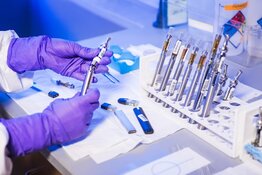The Life Sciences Report: It is clearly in a company's best interest to get all information out about therapies in development and to confront even negative news when it occurs. The Edison Investment Research business model is to produce corporate-sponsored research where the public company pays for the analyst's opinion. When there is a negative issue or event surrounding a company, how do you talk to your client about confronting the event?
Mike Aitkenhead: The nature of our client-sponsored research model starts from the moment we engage a research client. We are clear about providing balanced research, whereby we focus on both the positive and potentially negative aspects of the investment case—the risks and the opportunities. The client understands this when we start.
I'll give you the sum total of our views, and my view in particular. I worked within the traditional sellside (investment bank) research model previously, and think it's always in a company's best interest to be transparent about the news flow, whether good or bad. It's also in the analyst's best interest to present a balanced view, so that his or her credibility can be maintained with the investment community. Both must never lose credibility. That's key.
I think it comes across in our research product that we don't just present the positive aspects of any investment case. Indeed, we've had feedback from quite a few buyside (asset management) specialists, both in the U.S. and Europe, about our ability to tease out the various aspects of investment cases, which essentially enables analysts to make informed buy or sell decisions.
Finally, we don't have specific ratings or recommendations in our research notes, but we do endeavor to derive a fair value. In all the research that we write, we try to provide the investor with sufficient information to make a decent investment decision.
TLSR: Do you perceive that there are advantages to the corporate- or client-sponsored research model?
MA: One of the advantages of our model is that the relationship between the research house and the client is very clear. An annual retainer is paid for research, but we are transparent about that. In contrast to the sellside research model, we have no corporate brokering or investment banking relationship that could color our view on the particular stock of a company.
Coming from a sellside background, I'm acutely aware of the potential pressures on the analyst to write positive and/or supportive research to gain business for the investment banking side. People might argue that having a client-sponsored model is not impartial, but my argument is that it's potentially more transparent than what investors might see from some standard sellside research houses.
TLSR: You are a physician. Do you find yourself evaluating companies based on how a therapy might fit real patients, not subjects in a double-blind experiment with p values? Does that affect your thinking when you're looking at a drug candidate?
MA: My answer would be very, very much so. My approach to evaluating drugs is grounded in my background as a physician. While I'm always focused on clinical data, I try to consider a product's real world applications, how it might be utilized by physicians and perceived by patients. To that end, I try to look beyond simple statistics and endpoints to discover if a particular therapy offers clinically meaningful improvement over the standard-of-care therapy. I take a great interest in comparative effectiveness, and there is a real move, in Europe in particular, to look at the cost benefit of a drug. There is increasing interest in cost-benefit analysis in the U.S. as well.
I also draw on an extensive physician network, covering cardiovascular medicine, transplant surgery and pulmonary medicine, as well as other areas. I tap into these experts for views and insights. These are people with whom I've worked, so I know and trust them. They may not all be key opinion leaders, but they're on the ground treating patients, and they give me real feedback on what they perceive to be clinically meaningful improvements when I run data past them. The physician network element is very important to how I evaluate the companies.
Finally, I'm very keen on attending medical conferences. It's not so much about hearing the thoughts of key opinion leaders, who may have conflicts of interest due to relationships with the pharmaceutical or biotech companies that support their research. I go to the medical meetings to talk to the community physicians. When I go to neurology conferences, I try to talk to community neurologists about their views on the various drugs coming through the pipeline, what they see as being important to their patients, and whether drugs in development are actually useful for patients.
TLSR: Could we go ahead and talk about some companies? You choose the first one.
MA: CytRx Corp. (CYTR:NASDAQ) has a product, aldoxorubicin, on the cusp of entering phase 3 development. It's targeting a very large unmet need, soft tissue sarcoma (STS). Much of its competition is dropping away through failure of clinical trials, and aldoxorubicin looks to be one of the few late-stage drugs in development for this indication.
"It is in a company's best interest to be transparent about news flow, whether good or bad. It's also in the analyst's best interest to present a balanced view. Both must never lose credibility."
What makes aldoxorubicin particularly interesting is that it utilizes the STS standard-of-care chemotherapy agent, doxorubicin, conjugated to an acid-sensitive linker that binds to circulating albumin after it's given intravenously. The doxorubicin is then released into acidic tumor tissues. This is a targeted drug delivery, which has a number of advantages. It allows the drug to be retained primarily within the blood compartment and not distributed to healthy tissues and organs. That's important because one of the concerns with normal doxorubicin use is that the drug gets to the heart, where it can cause long-term damage, as well as into bone marrow and other parts of the body. Binding doxorubicin to albumin as a carrier through the blood is a very clever idea.
The preclinical data have been very supportive, and CytRx's phase 1b/2 trial has shown quite promising, albeit early stage, efficacy for this drug in patients with advanced STS. These data are encouraging enough for the company to take the drug forward into a pivotal phase 3 trial in second-line soft tissue sarcoma. The company secured a special protocol assessment (SPA) in April from the U.S. Food and Drug Administration (FDA), a written agreement that a single successful phase 3 trial would be sufficient to gain approval as a second-line therapy. We anticipate the trial will start sometime in H2/13.
Parallel to the development of aldoxorubicin as a second-line STS therapy is an ongoing phase 2b trial of aldoxorubicin as a frontline treatment for advanced soft tissue sarcoma. We expect that data sometime in H2/13, potentially toward the end of Q3/13. We have increasing confidence that this frontline trial will be positive because the trial recently passed an interim safety analysis, and further supportive data was recently published at the American Society of Clinical Oncology (ASCO) conference about the drug's efficacy and safety profile.
TLSR: This phase 3 pivotal trial has yet to begin, and we are probably looking at 2015 before we get any kind of definitive data, are we not? That's far off. Do you expect the phase 2b trial results as a frontline therapy later this year to be a catalyst?
MA: Our timeline assumes that we would have the data from the pivotal phase 3 sometime in 2015. We're targeting product launch in 2016. Near term, we have the results of the phase 2b trial in frontline soft tissue sarcoma. That's quite a large trial, with around 105 patients, and it's randomized. Furthermore, this is a comparator trial versus doxorubicin alone. I believe the results of the 2b trial will inform not only the company's plans for taking aldoxorubicin forward in frontline soft tissue sarcoma, but if it's positive, it should increase our confidence in the second-line opportunity as well.
The way the company has designed this phase 2b comparator trial, going head-to-head with doxorubicin, is wise because doxorubicin is the standard of care. If the frontline trial can show it's better than the standard of care, with the potential for better efficacy and/or better safety, that would increase our confidence in both the front- and second-line opportunities.
TLSR: Michael, you said that the competition was dropping away. No need to go into a long explanation, but what has failed recently in STS?
MA: If you look at the competitive space recently, you see the failure of ZIOPHARM Oncololgy, Inc. (ZIOP:NASDAQ) palifosfamide, which was an ifosfamide derivative. I was quite cautious about this therapy because the results of a large study, released toward the end of last year at the European Society for Medical Oncology (ESMO) conference, showed that adding ifosfamide (the parent compound of palifosfamide) to doxorubicin in frontline STS was no more effective than doxorubicin alone, and increased toxicity. The difference with CytRx's aldoxorubicin is that we already have a chemotherapy that works. Now we have a novel way of delivering that chemotherapy that is more targeted and potentially less toxic than doxorubicin itself.
TLSR: Soft tissue sarcomas are such difficult indications. Why are you optimistic about aldoxorubicin?
MA: I'll comment from the physician-based perspective. I attended the ESMO conference toward the end of last year, where I saw the aldoxorubicin data presented. I used that opportunity to speak to sarcoma physicians who also sat in on both the aldoxorubicin and ifosfamide presentations. They were all highly encouraged by the preliminary aldoxorubicin results. They also cautioned me about the need to monitor closely for potential side effects.
"My approach to evaluating drugs is grounded in my background as a physician."
As with doxorubicin we see some hematological toxicity, and that needs to be monitored in ongoing and future studies. Certainly, toxicity will be closely monitored in the current phase 3 pivotal trial, so appropriate treatment will ensure that we are not only improving efficacy but also minimizing toxicity. The physicians I spoke to felt that any increase in hematological toxicity should be quite easily managed with agents such as granulocyte colony-stimulating factor to treat or prevent neutropenia (low neutrophil, a type of white blood cell, count). The bottom line is that I came away from ESMO having spoken to a number of sarcoma physicians who were very encouraged by the initial results from this drug.
TLSR: Medical oncologists and heme/oncs (hematologists/oncologists) are using colony-stimulating factors on an everyday basis with their patients. These are typically not difficult issues for them.
MA: Yes. They're very adept at managing hematological toxicity. This is one of the areas where, as a physician, I try to delve into the data to find out what's meaningful. We know that sarcoma patients generally have fairly short lifespans when they reach advanced stages, so you're looking at relatively modest improvement in progression-free survival and overall survival. It is not only important to improve the efficacy of these agents, but also to be conscious of the side effects, attempting to maintain the quality of a patient's remaining life as well.
TLSR: With quality of life being an important result and primary endpoint, do you see progression-free survival is an adequate primary endpoint?
MA: Interestingly, in the SPA for the pivotal phase 3 aldoxorubicin soft tissue sarcoma trial, the primary endpoint is progression-free survival, with a secondary endpoint of overall survival. That speaks to the extremely high unmet need in sarcoma. It is our hope that we will not only see improvement in progression-free survival with aldoxorubicin, but also a meaningful improvement in overall survival.
TLSR: What's your next idea?
MA: Let's talk about OvaScience Inc (OVAS:NASDAQ). This company has a very novel approach to female infertility, in particular, improving the success rate of in vitro fertilization (IVF), which is the lead indication for its product, AUGMENT (autologous germline mitochondrial energy transfer). This unique technology is based on the groundbreaking work of Jonathan Tilly of Massachusetts General Hospital and Harvard Medical School. He has discovered germline stem cells in human ovaries that are effectively egg-producing stem cells.
The AUGMENT procedure involves extraction of fresh mitochondria (intracellular organelles that produce adenosine triphosphate [ATP], the chemical energy supply in cells) from these egg-producing stem cells, which are called egg precursor cells (EggPCs), and injecting that material into the egg of a woman undergoing the IVF procedure. This technology essentially revitalizes or rejuvenates the egg. There is a clear link between egg quality and the level of energy production in the egg, which relates to mitochondrial number and function, and the egg's ability to be fertilized and grow into a viable pregnancy resulting in live birth.
The idea is to improve the success rate of IVF and reduce the use of donor eggs, so that a woman may have a genetically matched child. The AUGMENT system will address a large and growing unmet need, particularly with women delaying childbirth to later years and the increasing awareness of infertility. To that end, OvaScience has embarked on a clinical study of AUGMENT in the U.S. to evaluate the technology.
TLSR: Let me understand this. The mitochondria from the egg precursor cells are mixed with sperm cells and injected into the oocyte. Is that right?
MA: That is correct. OvaScience has a proprietary process for identifying these precursor cells in ovaries, isolating the mitochondria and refining them. Essentially it purifies the mitochondria so that they are ready when the woman undergoes the IVF procedure. The sperm is injected into the egg and the mitochondria are injected at that same time.
TLSR: Clinical trials for cancer or other disease agents have defined endpoints associated with the disease. It would be interesting to know what the endpoints might be in the AUGMENT study.
MA: The AUGMENT study has a variety of endpoints—fertilization, implantation, pregnancy tests, scans, all the standard stuff you would follow for a pregnancy. But, ultimately, what OvaScience and investigators are looking for is safety. Is it a safe procedure? Is it effective? Does it improve the success rate as defined by a healthy live birth at the end of treatment? These endpoints will be compared, in part, to historic controls at the centers where the trial is being undertaken. You not only have quite a comprehensive database at each of these centers with regard to historical success rates for IVF at various ages, but there will be a selection of matched controls who are undergoing standard IVF at the same time. It is an interesting study design.
TLSR: So the historic and contemporary control subjects are patients who are not formally part of the clinical trial. Is that correct?
MA: Exactly right. You effectively have two forms of comparison with the AUGMENT procedure, a match with women who will receive IVF at the same time as the AUGMENT study, and also comparison to historic controls. U.S. fertility centers keep very good records for national databases.
TLSR: Going back to endpoints for a moment, is safety of the fetus the primary endpoint?
MA: Safety for both the mother and for the fetus.
TLSR: Would the secondary endpoint be the number of embryo transfers; the number of times it takes to produce a viable pregnancy?
MA: My understanding is that in the 40-patient trial, there will be only one attempt at embryo implantation in each woman. Also, only one embryo will be implanted. One of the potential advantages of the AUGMENT procedure is that it will reduce the need to implant multiple embryos into the uterus. There is a safety risk with multiple embryo transfers and pregnancies involving multiples. The idea is not only to improve the efficacy of IVF, but also improve the safety of the mother and the developing fetus.
One of the important things to remember about OvaScience is that a body of work already suggests that injecting mitochondria can improve the success rate of IVF. However, these previous studies have not used the woman's own germline, or egg-producing cells or mitochondria. They have used donor mitochondria, or mitochondria from somatic (non-gamete or non-germ) cells. The advantage of using a patient's own EggPCs and mitochondria is that you have pure, fresh, maternal mitochondria, and avoid the introduction of third-party genetic material into the egg at the time of the IVF procedure.
TLSR: AUGMENT is the lead program at OvaScience. What would be the catalyst that could move the stock? The reason I'm asking is because this stock is up 67% over the past six months and up 25% over the past 12 weeks. What are the market-moving events that could take these shares up further?
MA: The company is, quite wisely, not disclosing interim data from the AUGMENT study. That's useful because I don't think people should be misled. It has rightly kept things low key. The first real data point we'll have from the AUGMENT study will be in H2/14.
Between now and the end of this year, potential catalysts for OvaScience stock are threefold. First, I think we should get more clarity on the company's plans to commercialize AUGMENT outside of the U.S. Europe is potentially a much larger market than the U.S. in terms of IVF procedures, and there are other large markets like Brazil and Japan. I see clarity on the company's commercial development strategy outside the U.S. as a potential catalyst because we don't have much detail on that as yet.
The second catalyst would be expansion of the AUGMENT study in the U.S. in H2/13. Expansion would certainly be a positive sign for the program. Now that the company has raised $35 million ($35M), it is able to expand the study to include more U.S. patients.
The third catalyst could be potential updates on the progress of OvaTure, which is a preclinical program. OvaTure is a very interesting approach to infertility, one that could revolutionize IVF and the treatment of infertility. It essentially generates de novo eggs from the woman's own EggPCs. This would overcome some of the limitations encountered by women who are getting older and/or require donor eggs. If a new egg can be generated from an EggPC, it could extend the age at which pregnancy is possible. Any potential positive updates on the OvaTure program would certainly be a catalyst for the stock.
TLSR: When will OvaTure get into the clinic?
MA: I assume it will enter clinical development sometime toward the end of 2014.
TLSR: What is the regulatory pathway for these procedures and technology? Is it a device regulatory pathway? I have not seen any references to an investigational new drug application (IND), phase 1, 2 or 3 trials or new drug or biologics license applications (BLAs). What is the pathway?
MA: That's a very good question, and has been the subject of much discussion among the investment community. Essentially, OvaScience believes that the product is regulated under the 361 HCT/P pathway, which is for low-risk cell- and tissue-based products. One of the key criteria for 361 HCT/P is that there must be minimal manipulation, which is certainly the case with the OvaScience products as they use the patient's own cells. Under this regulation, AUGMENT would not be subject to a complete clinical study, review and approval process, as would a new drug or biologic.
The company admits that it hasn't formally consulted with the FDA's Tissue Reference Group, whose responsibility this would be. But the company doesn't have to consult if it believes the technology fits the 361 HCT/P requirements. OvaScience has sought a number of independent views about whether it meets those criteria, and management believes it does.
One of the potential risks is that the FDA might say the technology shouldn't be regulated under the HCT/P pathway, and could require a full BLA-type development program, which would be significantly more expensive. Currently, OvaScience is just doing the single, 40-patient study, which is effectively a marketing study to show the procedure is safe and has some effectiveness. But if it is does the expansion study, the company will build a much larger database to support the product going forward.
My belief is that while there is a risk that the FDA might disagree, AUGMENT appears to meet the criteria for 361 HCT/P product development. Only time will tell, but the company does mention in a Securities and Exchange Commission filing that it has ongoing interaction with the FDA, that the FDA is fully aware of the trial. So the FDA knows what's going on. The company is not carrying out its trial without any interactions or advice from its regulator.
TLSR: You have one more company that you wanted to talk about?
MA: Yes, GW Pharmaceuticals Plc (GWPH:NASDAQ). It's a United Kingdom-based company developing Cannabis-derived drugs for the treatment of various diseases. Its most advanced program is Sativex (delta-9-tetrahydrocannabinol [THC] + cannabidiol [CBD]), an oral spray administered under the tongue. It is already approved and marketed in Europe for the treatment of spasticity due to multiple sclerosis (MS).
The drug has been on the market in Europe for three years and the market is growing. GW Pharmaceuticals has partnered with Almirall S.A. (LBTSF:OTCPK) in Europe and Novartis AG (NVS:NYSE) in emerging markets. It is partnered with Otsuka Holdings Co., Ltd. (OTSKF:OTCPK) in the U.S., where it's in development for treatment of advanced cancer pain, but also soon for MS spasticity. The company has a validated cannabinoid platform that has generated an approved and marketed product that appears to be effective. It also has a broad pipeline of cannabinoid-based therapies in development for various diseases, such as glioblastoma, diabetes, schizophrenia and epilepsy.
What makes the story very interesting is that the company just completed an initial public offering on NASDAQ and raised $30M, which supports the company's strategy to advance its pipeline of cannabinoid therapies.
GW's U.S. partner, Otsuka, is currently running phase 3 trials with Sativex as add-on therapy to opioids in advanced cancer pain, with the first data due in 2014. Also, Otsuka has plans to initiate a phase 3 trial of Sativex in MS spasticity. I would anticipate that trial will start sometime next year. GW has entered the U.S. market at a good time. It has raised money to pursue its strategy and there is an increasing acceptance in the U.S., both politically and regulatory, toward the medicinal use of Cannabis.
TLSR: Michael, I'm curious about the phase 3 trial going on in the U.S. for cancer pain. Cannabis is not a narcotic. I know it works for nausea, but what is the mechanism that makes it work for pain?
MA: Two or three extensive phase 2 trials, one of which was undertaken in the U.S., have been done in the pain indication. There is a body of good, supportive clinical data in patients with advanced cancer pain. Going to your question of how it works, the underlying mechanisms of cannabinoid action are quite complex, and have not been fully defined. However, it appears that THC and CBD act via cannabinoid and, potentially, other receptors to induce analgesic effects. In addition, preclinical studies have shown that opioids and cannabinoids have synergistic analgesic effects.
TLSR: Has any potential for abuse been demonstrated? That's going to be a very important consideration in the U.S.
MA: If you look at the experience in Europe with the MS spasticity, there hasn't been any evidence of abuse potential with Sativex. I think that relates back to the combination of THC and CBD, which is a 1:1 ratio in the product. The company has specific strains of the Cannabis sativa plant that have been selectively bred to generate specific cannabinoids. But one way to reduce the abuse potential of Sativex is the route of delivery, as a sublingual spray, as well as its combination of THC and CBD. Certainly we don't see patients reporting the high one might experience by smoking Cannabis.
TLSR: It's been a pleasure speaking with you. Thank you for the time.
MA: Thank you for your time. It was a pleasure speaking to you.
Dr. Michael Aitkenhead is a qualified physician with more than 12 years' experience in the healthcare industry, including five years in clinical medicine and seven years in biopharmaceutical equity research. He was formerly a European pharmaceuticals analyst at the Royal Bank of Scotland in London, and prior to this was a European biotechnology analyst with Piper Jaffray. Aitkenhead received his medical degree from the University of Otago, New Zealand, and subsequently completed a master's degree in business administration at Judge Business School, University of Cambridge.
Want to read more Life Sciences Report interviews like this? Sign up for our free e-newsletter, and you'll learn when new articles have been published. To see a list of recent interviews with industry analysts and commentators, visit our Streetwise Interviews page.
DISCLOSURE:
1) George S. Mack conducted this interview for The Life Sciences Report and provides services to The Life Sciences Report as an independent contractor. He or his family own shares of the following companies mentioned in this interview: None.
2) The following companies mentioned in the interview are sponsors of The Life Sciences Report: CytRx Corp. Streetwise Reports does not accept stock in exchange for its services or as sponsorship payment.
3) Michael Aitkenhead: I or my family own shares of the following companies mentioned in this interview: None. I personally am or my family is paid by the following companies mentioned in this interview: None. My company has a financial relationship with the following companies mentioned in this interview: CytRx Corp., GW Pharmaceuticals Plc, OvaScience Inc. I was not paid by Streetwise Reports for participating in this interview. Comments and opinions expressed are my own comments and opinions. I had the opportunity to review the interview for accuracy as of the date of the interview and am responsible for the content of the interview.
4) Interviews are edited for clarity. Streetwise Reports does not make editorial comments or change experts' statements without their consent.
5) The interview does not constitute investment advice. Each reader is encouraged to consult with his or her individual financial professional and any action a reader takes as a result of information presented here is his or her own responsibility. By opening this page, each reader accepts and agrees to Streetwise Reports' terms of use and full legal disclaimer.
6) From time to time, Streetwise Reports LLC and its directors, officers, employees or members of their families, as well as persons interviewed for articles and interviews on the site, may have a long or short position in securities mentioned and may make purchases and/or sales of those securities in the open market or otherwise.














































